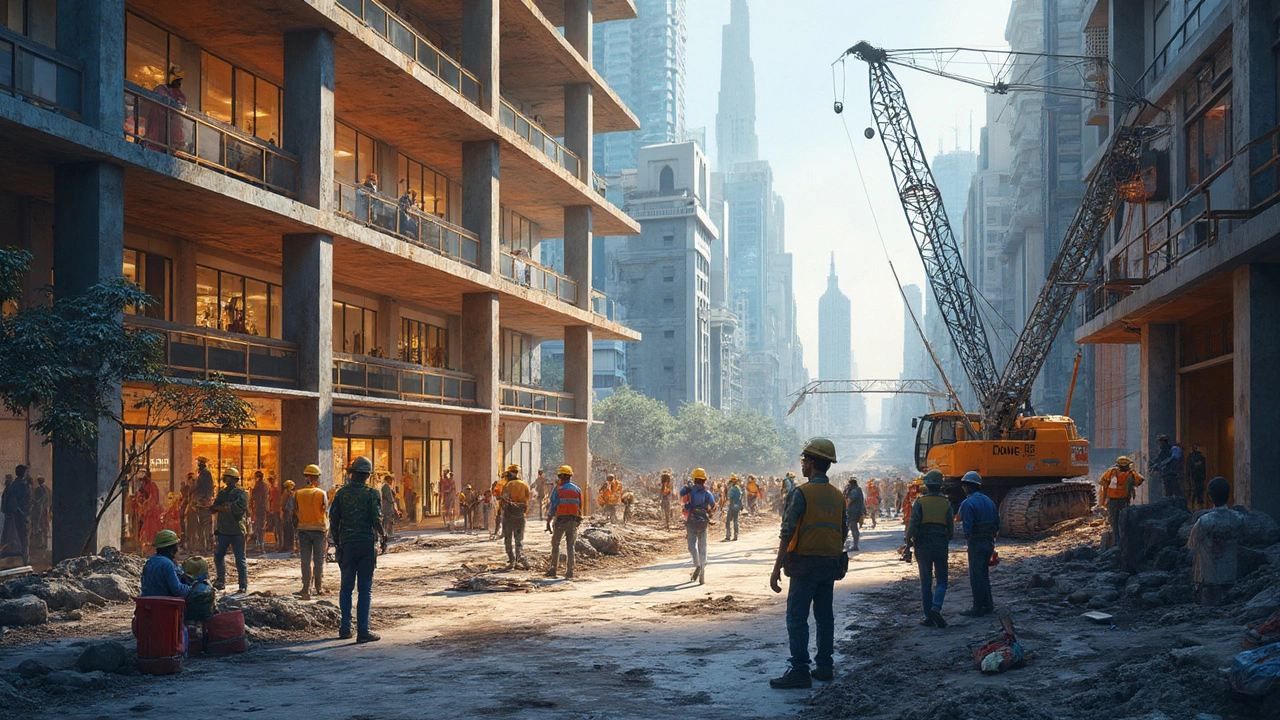If you're thinking about diving into the world of commercial construction, you've probably got a ton of questions—and rightfully so! Whether you're planning to build a snazzy new office or expand a retail space, knowing what is (and isn’t) covered can save you from potential headaches down the line.
First things first, let’s break it down: 'covered' in the commercial construction world can mean a couple of things. Are we talking about what gets built? Or are we tackling what insurance covers? Both are super important, and they often intertwine in unexpected ways.
Imagine you're creating a swanky apartment building. You need to make sure your contract spells out exactly what the builder will construct—from the foundation to the fancy rooftop garden you’re dreaming about. Getting an airtight contract isn’t just about what physical stuff is included; it’s also about setting the stage for who’s responsible for what during every phase of the construction.
- Understanding Commercial Construction Basics
- What's Typically Covered
- Important Exclusions
- The Role of Contracts
- Using Insurance to Manage Risk
- Tips for a Smooth Construction Process
Understanding Commercial Construction Basics
Commercial construction is more than just putting up walls and a roof. It’s a whole process that involves careful planning, the right team, and often a bit of patience. When you hear 'commercial construction,' think of projects like office buildings, hospitals, schools, or shopping malls. Basically, if it's meant for business and not for a single-family home, it’s commercial.
The journey usually kicks off with designing, where architects and engineers create a blueprint. This design stage isn't only about aesthetics; it’s also about functionality and adhering to local code requirements. Once the plans are set, it's time to get a building permit. This official approval is your green light to start construction—and it's non-negotiable.
Next up, finding the right construction team is crucial. You’re not just looking for someone with a hammer; you need everything from general contractors to subcontractors who specialize in plumbing, electrical work, and more. Quality and experience here can really make or break a project.
Here’s a little inside scoop: project management in commercial construction is a big deal. Somebody's got to keep all these moving parts from turning into chaos. A project manager's job is to ensure everything stays on schedule and within budget.
Speaking of budget, it’s not just about the upfront costs. Running over budget is one of the most common pitfalls in commercial construction. Always build a buffer into your budget for unexpected expenses. Trust me, you’ll need it.
Finally, once everything's been built according to plan (fingers crossed), there's an inspection phase. This is where officials check the work to ensure it's all safe, compliant, and up to snuff. With their blessing, you’re ready to move in or open up for business.
What's Typically Covered
Alright, let's get into the nitty-gritty of commercial construction. You might be wondering what actually gets built when you sign on that dotted line. This is where the magic—or sometimes chaos—can happen, depending on how well you understand what you're getting.
In most commercial construction projects, here's a rundown of what you can expect to be covered:
- Foundations and Framework: You’ve got to start from the ground up, right? This includes laying out the groundwork, such as concrete foundations and the primary structural framework. It’s the backbone of your building.
- Exterior Walls and Roofing: Think of this as the skin of your building—your walls and roof that keep the elements out. This usually involves everything from insulation to waterproofing.
- Interior Finishes: This covers all the inside flair—from drywall and flooring to those trendy glass partitions. It’s what makes the place look inviting.
- Mechanical Systems: Can't forget about the lungs of the building. This includes heating, ventilation, air conditioning (HVAC), and of course, plumbing.
- Electrical and Lighting: Power and light are obviously must-haves. Wiring, fixtures, and increasingly, smart tech are all part of the package.
Now, beyond the physical stuff, there’s the administrative side:
- Permits and Compliance: Making sure your project meets all legal requirements can’t be overlooked. This includes acquiring necessary permits and following building codes.
- Project Management Costs: Yeah, someone’s got to keep it all running smoothly. This includes managing timelines, budgets, and coordinating between various parties.
Sometimes these projects can get pricey, right? Check out this rough idea of what you might be looking at in terms of costs:
| Component | Average Cost % of Total Budget |
|---|---|
| Foundation and Framework | 15-20% |
| Exterior Walls and Roofing | 10-15% |
| Interior Finishes | 25-30% |
| Mechanical Systems | 10-15% |
| Electrical and Lighting | 5-10% |
Understanding these elements and keeping them in mind while planning your project can make a world of difference. It’s all about knowing where your money is going and what you're truly getting for it.
Important Exclusions
When diving into the world of commercial construction, being aware of what's not covered under your agreements and insurance policies can save you from major surprises. It's the stuff lurking in the fine print that often catches folks off guard. So, buckle up, let’s chat about those sneaky exclusions.
First off, many policies and contracts purposely exclude pre-existing conditions. Say you're renovating an old office building. If there are underlying problems, like pesky asbestos or dodgy wiring, your construction insurance might not cover these bad boys. You'll want to have detailed inspections before you even swing the first hammer.
Next, be mindful of natural disasters. Think your project site is immune to earthquakes, floods, or hurricanes? Think again! Many standard plans exclude these acts of nature. You'd have to snag extra coverage or deal with the potential aftermath out of pocket.
Contractually, delays due to unforeseen events often aren’t covered either. Imagine the horror of discovering your material shipment is stuck at the port due to some strike. Your contract might not have provisions for such delays, leaving your timeline in limbo and costs escalating.
Material defects and faulty workmanship are typically big no-nos in coverage unless you have warranties in place. So, if things start to fall apart literally after the project is done, don’t bank on insurance to bail you out.
Here's a quick look at some common exclusions:
- Pre-existing conditions
- Natural disasters
- Unforeseen project delays
- Material defects and workmanship issues
A tip? Always scrutinize contracts and insurance documents. Chat with both your contractor and insurance agent to tweak coverages aligning them with your project's specific needs.

The Role of Contracts
Alright, let’s get real—contracts are the backbone of any commercial construction project. They’re the detailed rulebook everyone agrees to play by. Without a solid contract, you're basically diving into a project blindfolded.
First up, contracts define what exactly is going to be built. This includes the scope of work, materials used, timelines, and even the design specifics. It’s like having a blueprint for success. You've got to be crystal clear about your expectations—no room for assumptions.
Let's talk money—contracts also outline the payment terms. You don't want to be caught off guard when it comes to costs. Usually, payments are broken down into stages, like when the foundation is complete, and it helps keep everything on track.
Here's a pro tip: make sure there's a section for handling changes. Construction projects rarely go perfectly according to plan. Whether it's a design tweak or a supply hiccup, a good contract will have a method for dealing with changes without causing chaos.
Ever wondered who deals with what? Contracts assign responsibilities to each party involved. If something goes wrong, you’ll know who's supposed to handle it. This clarity is golden—it prevents those 'I thought you were doing it' moments.
Communication is key. A well-crafted contract sets the stage for clear, open communication between all parties, from contractors to architects to the client. Miscommunications can lead to delays, and nobody wants that.
Finally, don't shy away from getting a lawyer involved. Legal experts can spot potential issues and strengthen your contract. Think of them as a safety net protecting your project and your investment.
Using Insurance to Manage Risk
Insurance might not be the most thrilling part of commercial construction, but it’s definitely the unsung hero that can save your bacon when things go sideways. Think of it as the safety net that has your back throughout the entire building process.
First up, you’ve got construction insurance. This is a must-have to help manage unexpected bumps in the road—anything from a sudden storm causing damage to theft of building materials. Typically, this type of insurance covers property damage, equipment breakdowns, and even some liability issues.
Also, let's not forget about Builder’s Risk Insurance. It specifically covers the building itself while it’s under construction. So if, say, a part of your new office collapses because of a freak windstorm, you'll be covered. This insurance is usually specialized to cover everything from the freshly poured concrete to the plush carpeting that's awaiting installation.
Then there’s liability insurance. This one's crucial for protecting you if someone gets hurt on the site—because let's face it, construction sites can be risky. Having this insurance means you're not on the hook for hefty medical bills should an accident occur.
- General Liability Insurance: Covers stuff like injuries and property damage on site.
- Professional Liability Insurance: Helps if there are design mess-ups or if a blueprint detail leads to a snag.
- Workers’ Compensation: A must-have to cover employee injuries on the job.
Making sure these insurance policies are in place before the first shovel hits the dirt can prevent cash drain nightmares. Talk with your insurance provider early in the project, ask all those 'what if' questions, and get everything in writing. The more you understand what’s covered, the better you can sleep at night while your construction project hums along.
In essence, being proactive with your insurance choices can mean the difference between a smooth commercial construction experience and a costly fiasco.
Tips for a Smooth Construction Process
Getting a commercial construction project off the ground can feel like juggling flaming chainsaws. But fear not! With the right approach, you can keep everything from falling apart. Here are some tried-and-true tips to help your project sail smoothly:
- Plan Thoroughly: Start with a detailed blueprint of your project. This should include everything from timeline to budget. Having clear goals and milestones can help keep everyone on track. It's like having a road map when you're on a long road trip.
- Communicate Clearly: Make sure you’re talking regularly with your contractors, architects, and insurers. Keeping everyone in the loop can help prevent misunderstandings and ensure they all know what's covered.
- Get the Right Permits: Don't skip the paperwork! Securing necessary permits early keeps the city inspectors happy and avoids annoying delays.
- Use Quality Materials: Investing in good materials now can save money on repairs and replacements later. It’s like buying a good pair of shoes; a little extra cost upfront saves headaches later.
- Monitor Progress: Regular site visits are crucial. Check that the construction matches the blueprints and stays on schedule. This is your chance to catch any issues early.
- Be Flexible: No project goes perfectly. Being ready to adjust to unexpected changes can keep things moving. Flexibility is your best friend here.
Following these steps can transform a potentially chaotic building effort into a well-oiled machine. Remember, the goal is not just to finish but to build something that stands the test of time. With some planning and persistence, you'll have a smooth construction experience.

Written by Fletcher Abernathy
View all posts by: Fletcher Abernathy